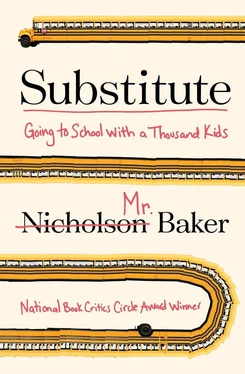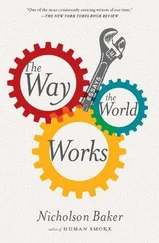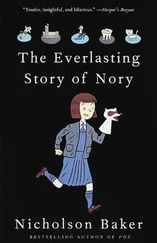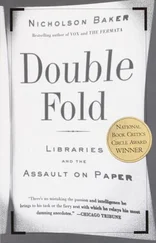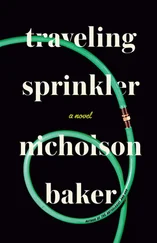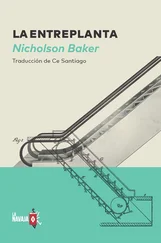I asked her about math requirements. Everyone had to take Algebra, Geometry, and Algebra II, she said. Financial Algebra was a half-credit course, and her kids didn’t really understand it, but they tried. She packed up her lunch things and went over to talk to Drew. “I’m on this side of the room just so I can irritate you,” she said to him. “I love it when I can irritate you, it just makes my day.”
“I’ll scare you,” said Drew.
“You’re not going to scare me.”
“I scared you that one time, I can scare you again.”
Mrs. Meese laughed.
“It’ll happen again,” said Drew.
“One day you’re going to scare the living crap right out of me again,” said Mrs. Meese. “I believe you.”
Drew told us about an April Fool’s trick one of his teachers did at his old school. “She took this teacher’s keys to the lunchroom, and before they made the Jell-O, she told them, ‘Put the keys in the Jell-O and serve that to her during lunch.’ She got her Jell-O and saw her keys.”
“I hope they cleaned her keys before they got put in that Jell-O!” said Mrs. Meese. “Yuck.”
“One teacher was kind of short,” Drew went on. “They put a pie over the door so that it fell right on him when he came in. It was the funniest thing I have ever seen.”
The bell rang for block 4. I walked out to one of the modular classrooms in the back of the school, near the football field, where there was a community safety class taught by Ms. Accardo, a petite smiley woman with big hair and big moves. She looked like a dance instructor giving a TED talk. As soon as the bell rang, she said, “Well! Got some review stuff for you guys! After, of course, I do attendance!” While she called names, a kid named Ronald unwrapped a sandwich and began eating it. “Just so you know,” she said, “the people listening to the iPads, if that’s what you need to do in order to focus, I’m fine with that, BUT! If you spend time in class trying to find the right song, I do have a problem with that. So just a little FYI, wanted to get that out of the way.”
She twirled on her feet and held out a finger. “Okay! What four things will clue you in about an emergency existing?”
“Behavior,” said Ronald, chewing his sandwich.
“Unusual behaviors!”
“Smell,” said Cayley.
“Unusual smells!”
“Sight,” said Anabelle.
“Unusual sights!”
“Sounds,” said Kiefer.
“Unusual sounds! Those are the four things. Very good. Okay. That will trigger, or should trigger, your rescue radar to go off. And why don’t people get involved in rescue situations?”
“They don’t know what to do?” said Kiefer.
“They don’t know what to do!”
“They don’t want to be responsible?” said Anabelle.
“They don’t want the responsibility of helping! They don’t want to get involved! And why don’t they want to get involved?”
“Because they’re afraid they might mess up?” said Andrew.
“They’re afraid they might make a mistake! And what happens sometimes when people make a mistake and hurt somebody?”
“Get sued?” said Andrew.
“They’re afraid they’re going to get sued! What are some other reasons people don’t help?”
Cayley said that you could be self-conscious.
Ms. Accardo made a slow, wide-eyed nod, turning to look at everyone in the class. “You’re going to have a big old crowd of people, crowding around, staring at you rescuing somebody! Anything else? Sometimes people are scared of catching a disease. Or they’re all grossed out, because sometimes rescuing people is nasty. It’s gross.”
Ronald raised his hand. “They think that people already have it under control.”
“Yeah. ‘Oh, there’s people there! Somebody’s taking care of that.’ Big ole assumption! Okay, so what we’re doing now is we’re taking away a lot of those reasons for people not to get involved.”
She told us how to obtain consent to help someone who is hurt. “What happens if someone is spewing blood all over the place, and they go, ‘Get away!’?”
“Call 911?”
She pointed at the girl, Jennifer, who’d said this. “Call. You cannot tackle them! And put bandages all over them! Can’t do it. Now, if they go, ‘Go away’—and then pass out? A reasonable person would want assistance if they were unconscious and severely injured. You can help now — even though they said go away before they passed out.”
But never try to do something that is outside your scope of training, Ms. Accardo warned. To illustrate this, she offered a vivid retelling of the tracheotomy scene in The Heat , which was, she said, “an R-rated flick with a lot of f-bombs.” The guy’s choking, and Sandra Bullock shouts, “I got this! Give me a knife!” She jams it into the guy’s throat, and the blood starts spraying out, and she panics. The guy is practically dying, and she’s horrified. The moral being that you don’t know how to do something just because you saw somebody do it on TV. And always, always, Ms. Accardo said, before you help somebody, tell them what you’re up to. “Your doctor tells you what he or she is doing. They just don’t stick their hand up your shirt, right? With the stethoscope? They tell you what they’re doing! You need to do the same, so you don’t look like some creeper!” After giving us several more pieces of advice, she played a video about how to move a victim, using an assist , a carry , or a drag . We watched how to do a two-person seat carry. If the victim has a head or spinal injury, you must perform a clothes drag . “Support the victim by gathering the clothing behind the head and neck,” said the male narrator, in a soothing voice. “Move the victim by holding on to her clothing, and dragging her.”
“You don’t HAVE to move the victim,” said Ms. Accardo, after the movie was over — you only had to move the victim if the place where the victim lay prevented proper care. “Example! The person’s on the bed, and you have to give CPR. You’re just going to bounce them! You’ve got to get them on a firm surface to get compressions.” The lunch bell rang and everybody left, leaving their backpacks behind.
“That was a pleasure,” I said. “I didn’t do anything, but I’m happy to be in your class.”
“Well, thank you,” said Ms. Accardo. “We’re going to go to lunch, and then we’re going to come back.”
We went to the teachers’ lunchroom, and Ms. Accardo introduced me to several teachers sitting at a round table. I started eating a chicken-salad sandwich. One of the teachers, Mrs. Plaistow, told a story of getting locked out of her lakeside camp cottage. She was out walking her dog, when her daughter went out to smoke a cigarette and forgot to bring her keys with her. Mrs. Plaistow went to a neighbor’s house to ask for help. A fifteen-year-old kid came to the door in boxers. “That’s all he’s got on is boxers. Two black Labs barking their heads off. He says, ‘I’ll go over, we’ll break into your camp.’ His dad pulls on his pants, he says, ‘I’ll go over.’” The dad went to work on the door with a credit card. “Forty-five minutes, he struggled with that door,” said Mrs. Plaistow. “I said, ‘I feel so much better! You say you’ve never had a latch you couldn’t get open, and you’re struggling.’ He goes, ‘Don’t remind me.’ He goes off to get a sledgehammer to break the lock. Three hours, standing in the cold. The dog was happy, he was playing in the snow.” She offered the son and the dad some deer-meat chili. “The dad says, ‘You don’t have to give us any chili. This is what neighbors do. Someday we might need something from you.’ I said, ‘That’s probably doubtful.’ He goes, ‘Yeah, probably it is. But you never know.’” End of story.
Читать дальше
